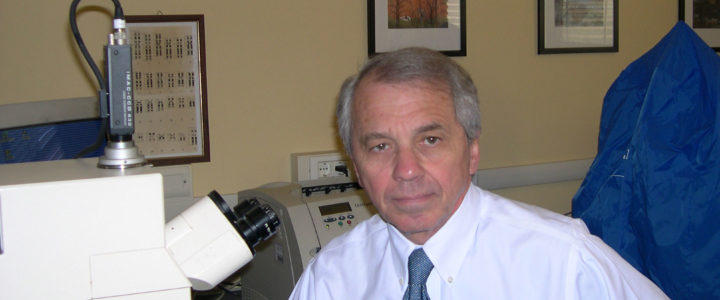With more than $1,000,000 from FRAXA Research Foundation over 13 years, Drs. William Greenough and Ivan-Jeanne Weiler at the University of Illinois uncovered the role of FMRP at synapses, leading to much of the subsequent research on Fragile X syndrome.
Read more3 Researchers Honored at FRAXA Investigators Meeting
Over 150 scientists from around the globe gathered in Durham, New Hampshire, for FRAXA Research Foundation’s Investigators Meeting on September 21-24, 2008. They came from Australia, Canada, India, Turkey, the U.S., and eight European countries. Their common goal: “to share, collaborate and publish,” in the words of FRAXA’s Medical Director, Michael Tranfaglia, MD, to find effective treatments and a cure for Fragile X, the foremost inherited cause of mental retardation and autism. Most of the attendees were university-based professors, postdoctoral fellows, and graduate students who have FRAXA research grants. Also participating in the meeting were scientists from the National Institutes of Health (NIMH, NICHD, and NINDS), Neuropharm Group PLC, Hoffman LaRoche Inc., GlaxoSmithKline, Indevus, and Seaside Therapeutics, as well as 20 parents of Fragile X children.
Read more
Researchers Propose Minocycline to Treat Fragile X
A University of California Riverside team of scientists has found that an available drug called minocycline, used widely to treat acne and skin infections, might also be used to treat Fragile X. The study’s findings have already led to the approval of a FRAXA-funded clinical trial in Toronto, Canada, that will test minocycline in patients with Fragile X.
Read more
Altered Cyclic AMP Signaling in Fragile X
With $125,000 grant from FRAXA Research Foundation over 2006-2008, Dr. Anita Bhattacharyya at the University of Wisconsin Waisman Center investigated abnormalities in cyclic AMP signaling in Fragile X syndrome. Results published.
Read more
Glutamate Metabolism in Fragile X Mouse Brain
With a $95,000 grant from FRAXA Research Foundation over 2 years, Mary McKenna at the University of Maryland studied the role of metabotropic glutamate receptors (mGluR) and how they affect other cells and pathways.
Read more
Using Fenobam to Reduce APP and Abeta in Fragile X Mice
With a $130,000 grant from FRAXA Research Foundation over 2008-2009, Drs. James Malter and Cara Westmark at the University of Wisconsin studied the relationship between the Fragile X protein FMRP and APP, a protein important to the pathology of Alzheimer’s Disease. APP may also contribute to the pathology of Fragile X, and its major metabolite, Aß, may contribute to abnormal protein synthesis via a positive feedback loop. This project sought to restore normal dendritic protein synthesis in Fragile X mice by breaking into this loop.
Read more
In Vivo Imaging of Synaptic Abnormalities in a Mouse Model of Fragile X Syndrome
With an $85,000 grant from FRAXA Research Foundation over 2007-2008, Dr. Wen-Biao Gan and his team at New York University studied in-vivo protein development using imaging in mouse models to determine when pre- and postsynaptic structural plasticity occurs to target and when it develops abnormally.
Read more
Sleep and Circadian Rhythms in Fragile X Mutant Drosophila
With an $80,000 grant from FRAXA Research Foundation over 2 years, Dr. Ravi Allada and his team studied at Northwestern University sleep behaviors in Fragile X fruit flies. These fruit flies are useful for several important reasons; not only do they have a good cognitive phenotype, they also have a clear disturbance of circadian rhythms. This is an important model for human hyperactivity and sleep disorders, and this group studied the underlying mechanisms in an effort to find treatments for the human conditions.
Read more
AMPAkines and BDNF in Fragile X: UCI Researchers Restore Memory Process in Fragile X
With a $104,498 grant from FRAXA Research Foundation from 2003-2008, Dr. Julie Lauterborn at the University of California has done several studies on dentritic spines and finding treatment targets for memory retention in Fragile X mice.
Read more
Development of the Fragile X Brain: Cellular Processes Regulated by FMRP During Development
With a $120,000 grant from FRAXA Research Foundation over 2 years, Dr. Peter Kind and his team at the University of Edinburgh will study the way FMRP affects and is affected by cortical development.
Read more
Targeting the Role of Group 1 Metabotropic Glutamate Receptors
With a $40,000 grant from FRAXA Research Foundation in 2008, Dr. Huibert Mansvelder and his team at the University of Amsterdam studied the role of different receptors and their reactions to drug compounds.
Read more
Effects of Alternative Splicing at FMR1 Exon 15 on Understanding Fragile X Syndrome
With a $118,500 grant from FRAXA Research Foundation from 2007-2008, Dr. Robert Denman and his team at the New York State Institute for Basic Research studied protein splicing, specifically looking at exon 15-encoded residues of of FMPR.
Read more
Molecular Basis of Fragile X Syndrome: Genetic Modeling in Zebrafish
With a $52,500 grant from FRAXA Research Foundation in 2008, Dr. Robert Richards and his team from the University of Adelaide studied zebrafish models and embryo development abnormalities to search for treatment targets.
Read more
In Vitro Reactivation of the Fragile X Gene
With a $60,000 grant from FRAXA Research Foundation, Dr. Giovanni Neri and his team at Universita Cattolica del S. Cuore explored reactivation of the FMR1 gene and characterization of cell lines with unmethylated full mutation.
Read more
Doris Buffett’s Challenge Grant to FRAXA: Over $1.5 Million for Research!
In the Spring of 2007, Doris Buffett, president of the Sunshine Lady Foundation, challenged FRAXA to raise $500,000 in new funds by November 1 which she’d match. The grand total of new donations received was $1,424,562, with an additional $98,755 in pledges payable by March 1st, for a total of $1,523,317! Together with Ms. Buffett’s initial $500,000 gift, FRAXA received over $3.5 million in new money — all for research aimed at curing or treating Fragile X. Thanks so very much to all of you who helped make this happen. More than 2600 people donated toward the Challenge – it is a true grass-roots community success.
Read more
Clinical Trial of Aripiprazol in Fragile X Syndrome
With a FRAXA Research Foundation grant of $30,000 in 2006, Dr. Erickson conducted a pilot clinical trial of an available medicine, aripiprazole (brand-name Abilify). This was an open-label 12-week trial in 12 people ages 6–25 years with Fragile X. Results were promising, and published: 10 of the 12 participants showed behavioral improvements.
Read more
FRAXA Contributes $10,000 to NIH grant to Seaside Therapeutics
Randy Carpenter, MD Principal Investigator with Mark Bear, PhD, MIT Co-Investigator (2007) conducted a clinical development of mGluR5 antagonists to treat Fragile X Syndrome and Autism. Seaside Therapeutics received a major grant from the NIH, with additional funding from FRAXA and Cure Autism Now (CAN) to develop STX107, a selective mGluR5 antagonist, as a treatment for Fragile X. Unfortunately, Seaside has since discontinued development of STX107.
Read moreTaurine and Somatostatin as Potential Treatments for Fragile X Syndrome: A Unifying Neuro-Endocrine Hypothesis
With a $74,000 grant from FRAXA Research Foundation, Dr. Abdeslem El Idrissi at CUNY explored the GABA receptor system in Fragile X mice and tested somatostatin and taurine as potential therapies for Fragile X; while somatostatin must be infused intravenously, taurine is available as a nutritional supplement.
Read more
FMRP-MAP1b RNA Interactions in Fragile X Syndrome
With a $95,000 grant from FRAXA Research Foundation from 2006-2007, Dr. Mihaela Mihailescu and her team at Dusquesne University studied the relationship between FMRP, RNA sequences, and G quartet structure. Results published.
Read more
Regulation of Group I Metabotropic Glutamate Receptor Trafficking in Fragile X
With an $83,500 grant from FRAXA Research Foundation in 2005 and 2007, Dr. Anna Fracesconi at Albert Einstein College studied the patterns and pathways of different receptors related to Fragile X.
Read more
Decreased Excitatory Drive onto Parvalbumin-Positive Neocortical Inhibitory Neurons in a Mouse Model of Fragile X Syndrome
With an $80,000 grant from FRAXA Research Foundation over 2006-7, Drs. Jay Gibson and Kimberly Huber at the University of Texas at Southwestern examined if the defected inhibitory neurotransmission was a primary or secondary symptom of Fragile X to determine where future treatment targets should be focused.
Read more
Electrophysiological, Biochemical and Immunohistochemical Characterization of Kv3.1 in Auditory Brainstem Nuclei in the Fragile X Knockout Mouse
With $80,000 in funding from FRAXA over several years, the Yale University team of Leonard Kaczmarek, PhD showed that loss of FMRP leads to an increased Kv3.1 potassium currents. This change impairs timing of action potentials in auditory neurons (and likely others throughout the brain).
Read more
Baclofen: GABA(B) Receptor Supersensitivity and Normalization of Behavioral Abnormalities by Various GABA(B) Agonists Including Baclofen in FMRP Deficient Mice
With $110,000 in grants from FRAXA Research Foundation over several years, Dr. Miklos Toth from Cornell University discovered increased startle response in Fragile X mice and that baclofen can correct this phenotype.
Read more
Hypothalamic Pituitary Adrenal (HPA) Axis Dysregulation in Fragile X Syndrome
The hypothalamic pituitary adrenal (HPA) axis is our central stress response system. FRAXA Research Foundation awarded Dr. Carolyn B. Smith $62,000 in funding in 2005 to explore the HPA axis in Fragile X mice. The results of their study indicate that, in FVB/NJ mice, the hormonal response to and recovery from acute stress is unaltered by the lack of Fragile X mental retardation protein. Results published.
Read more
Defining Functional Domains of FMRP and Uncovering its Partners via Large Scale Mutagenesis in Drosophila
With $80,000 in funding from FRAXA Research Foundation in 2005 and in 2006, Dr. Yong Zhang and his team at the Chinese Academy of Sciences developed a way to find genes that suppress the Fragile X gene. FRAXA grants $40,000 (2006) and $40,000 (2005) by Xinda Lin show that FMRP is a widely expressed RNA-binding protein involved in RNA transport and translation. Intensive studies in the last decade have demonstrated that FMRP contains four RNA binding domains, but their actual functions are mostly untested. Meanwhile, a dozen or so protein partners and hundreds of mRNA targets interacting with FMRP have been identified, but again their functions are poorly understood.
Read more
